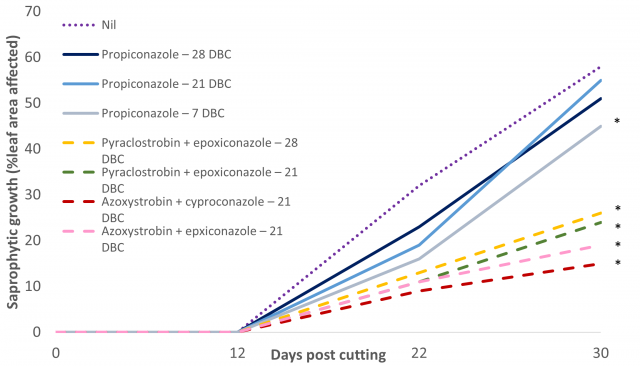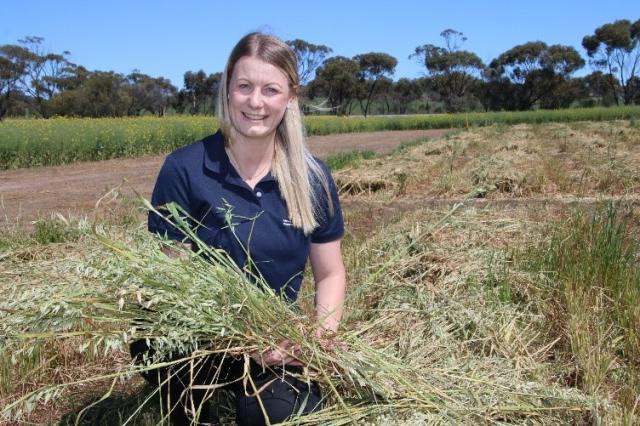This issue of Protecting WA Crops focuses on oat pathology and the findings from the recent National Hay Agronomy project, led by Georgie Troup (DPIRD), supported by AgriFutures Australia and in collaboration with Agriculture Victoria. Dr Kylie Chambers and Geoff Thomas (DPIRD) led the pathology of the oaten hay section of the three year project.
In this issue we cover:
- How late season fungicide application suppresses weather induced saprophytic fungal growth in oaten hay windrows
- The impact of Septoria avenae blotch and leaf rust on oaten
- A new disease in WA oats; Red leather leaf
- Team member Dr Kylie Chamber’s profile
Late season fungicide application suppresses weather induced saprophytic fungal growth in oaten hay windrows
Strobilurin fungicides can improve the visual quality of hay by reducing saprophytic fungal growth in oaten hay windrows.
At a glance
- Saprophytic fungi that develops during windrow curing, after rainfall events, feed on decaying leaf material and subsequently reduce the visual quality of the hay and its suitability for export markets.
- Trials found that strobilurin fungicides reduced the level of saprophytic growth in the windrows by approximately 55-85% and had larger and more consistent effects than triazole fungicides.
- The application of strobilurin fungicide 21 (withholding period) or 28 days prior to cutting offered similar levels of protection against saprophytic growth.
Saprophytic fungi such as Alternaria spp. and Cladosporium spp. can develop on the windrow following rainfall events during the curing process. These saprophytes feed on the dead or decaying leaf material and subsequently reduce the visual quality of the hay and its suitability for export markets. This can in turn affect the potential economic returns for growers.
Anecdotal evidence has previously suggested that late season applications of strobilurin fungicides can reduce saprophytic growth and increase green leaf retention in the windrow thus improving hay visual quality. To test this theory research trials were conducted in Western Australia (WA) and Victoria over three seasons (2019-2021).
Strobilurin (Qol group 11) and triazole (DMI group 3) based fungicides were applied at either 7, 21 or 28 days prior to hay cutting (note: these timings comply with withholding periods on the labels for export hay). Plots were swathed at Z71 (recommended growth stage for optimum hay quality), windrowed and weathered for up to 45 days to allow saprophyte colonisation. The WA trials were artificially irrigated to simulate rainfall events on the windrow.
The project team, compromising of plant pathologists Dr Kylie Chambers, Geoff Thomas (DPIRD), Dr Hari Dadu and Dr Mark McLean (Agriculture Victoria), found that strobilurin fungicides reduced the level of saprophytic growth in the windrows by 55-85% and had larger and more consistent effects than triazole fungicides (Figure 1).
Dr Chambers said growers were also interested in the performance of the triazole fungicide propiconazole, as it is cheaper than other fungicides and has a shorter withholding period compared to the strobilurin based fungicides (7 days versus 21 days). However, while propiconazole applied at 7 days prior to cutting significantly reduced saprophytic growth, strobilurin based fungicides applied at 21 or 28 days before swathing significantly outperformed the triazole fungicides (Figure 1).
Dr Chambers said the results indicate it may be better to spray earlier in the season to get both effective foliar disease control and potential suppression of saprophytes in the windrow with a single application. She found that the application of strobilurin fungicide 21 or 28 days prior to cutting offered similar levels of protection against saprophytic growth (Figure 1). She added that hay crops can finish quicker than expected in some seasons and the earlier application timing can provide a buffer for growers to cut hay earlier than expected and still comply with withholding periods. Dr Chambers found that all the registered strobilurin based fungicides used in the trials provided similar levels of saprophytic growth suppression (Figure 2). She stressed it is important to check the strobilurin fungicide you are applying in season is registered for management of the disease you are hoping to control.
Fungicides were observed to have the greatest effect on the surface of the windrow, where more saprophytic colonisation occurred. The team believes this is most likely due to saprophytes preferring to feed on the sun-bleached tops of the windrow where there is more decaying leaf tissue. Fungicides had little to no effect inside the windrow.
The application of late season fungicides did not impact on hay nutritional quality or affect the overall “greenness” of the hay either at cutting or in the windrow. However, the difference in saprophytic growth could impact on overall hay visual quality if the bleached portion made up a high percentage of the windrow, and result in a downgrade of hay quality and value for the producer.


It is important that fungicide groups are rotated and that fungicides are only applied to address foliar disease risk(s) at the time of application. Following label recommendations for application rates and withholding periods is important to avoid the risk of chemical residues in hay and potentially jeopardising export markets.
The National Hay Agronomy project, co-funded by AgriFutures, is a collaboration between DPIRD and AgVictoria with input from Dr Kylie Chambers and Geoff Thomas (DPIRD) and Dr Hari Dadu and Dr Mark McLean (Agriculture Victoria).
For more information refer to the 2020 GRDC Research Update presentation Strobilurin fungicides protect oaten hay from weather damage? Myth or fact?

